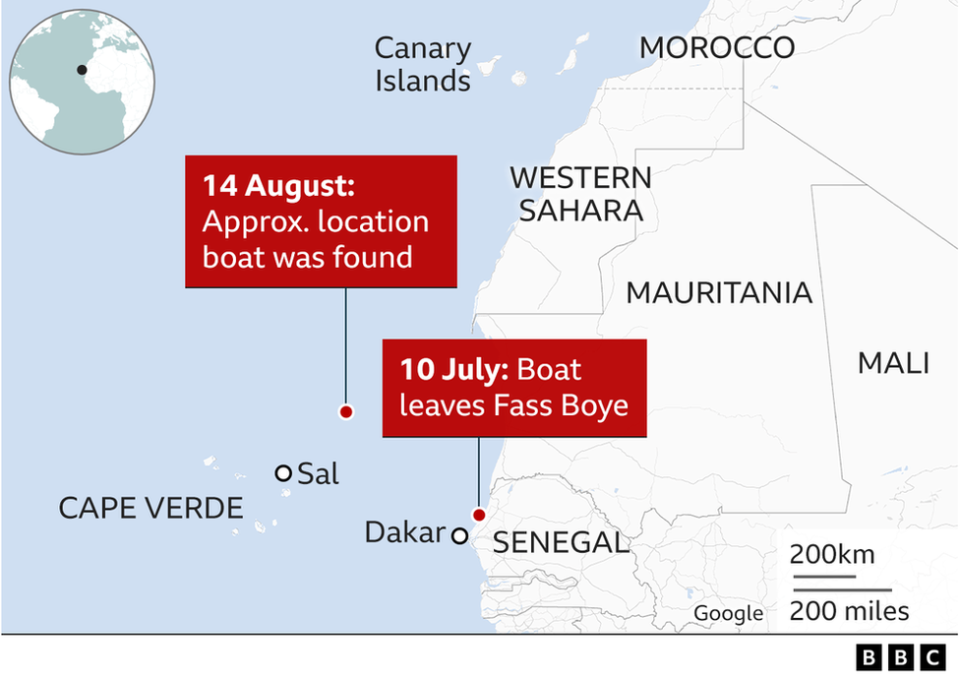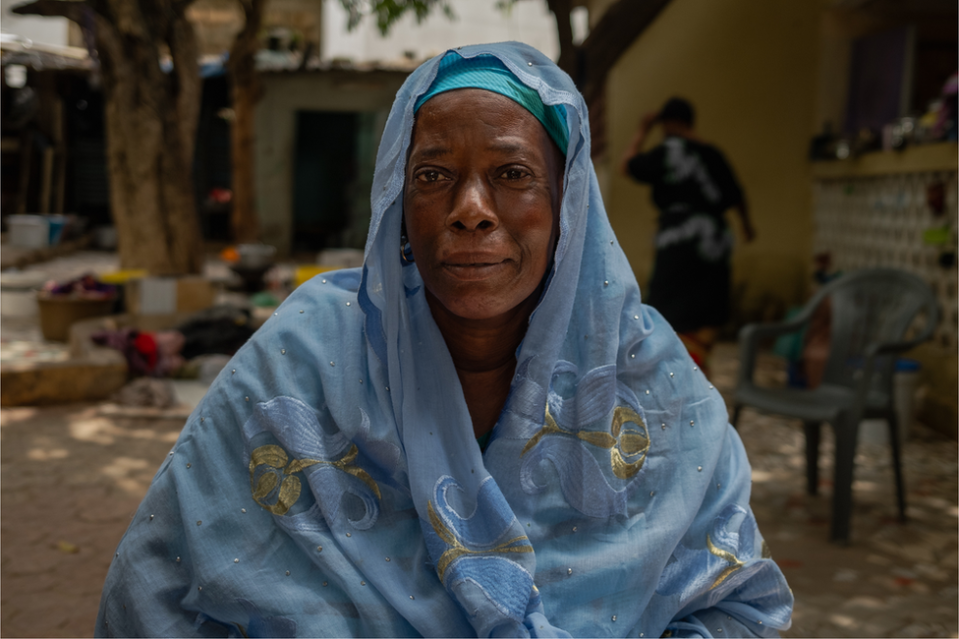Adama and Moussa Sarr had lost track of the exact number of days they had been at sea.
The brothers were drifting somewhere off the coast of West Africa, in a traditional Senegalese fishing canoe known as a pirogue. They were two of 39 passengers in total – all malnourished, many close to death.
When a fishing vessel appeared in the distance one day, Adama, 21, was so weak he could only stare, he said. Moussa, 17, slipped into the water to swim.
He would almost certainly have drowned, had the fishing crew not spotted him in the water and plucked him to safety.
When they drew alongside the pirogue, they found Adama and the rest of the survivors and seven bodies. The pirogue had set out from Senegal five weeks earlier, with 101 souls on board.
The survivors had drifted hundreds of miles on one of the most dangerous migrant routes in the world – the North Atlantic sea passage from Senegal to the Canary Islands, a Spanish archipelago about 1,000 miles away by sea.
They had left on 10 July, from the coastal village of Fass Boye. Adama and Moussa came from a long line of fishermen in the village. The boys learned to fish together and worked a pirogue together.
But like many young people in Senegal, they felt the pull of Europe. “Everyone wants to go on the boats,” Adama said. “It’s the thing you’re supposed to do.”
He was sitting in the shaded courtyard of a family home, safely back in Senegal but noticeably thinner than before. The journey had begun at dusk, he said. He and Moussa, along with two cousins, Pape and Amsoutou, aged 40 and 20, joined the pirogue a little way off the coast as it set off into the night.
Unlike the Mediterranean, there are no patrols on the North Atlantic route – no-one proactively searching for lost or distressed boats. It is easy to founder without being seen. If you miss the Canaries, or Cape Verde, you can drift into the Atlantic and disappear.




For the first three days, Adama and Moussa’s pirogue, powered by an outboard motor, battled against strong headwinds. But on the fourth day, the wind died down and the boat began to progress, Adama said. The passengers believed they had only a few more days at sea.
When the sixth day passed with no sight of land, an argument erupted over whether to push on or turn back.
“The captain ruled that we should push on, because we had enough food and water and the wind was quiet,” Adama said.
The passengers grew confident again and began to eat lots of food, he said, and they used drinking water to wash their hands for prayers.




It was around day six that the food and water began to run out. There were four children on board, and some older people gave the last of their food to the young. Some hoarded even after people began to die.
Adama couldn’t remember the exact date of the first death, but it was shortly after the first week passed, he said – a fishing captain, used to being on the water but not young. It was six more days until the next person died. Then the deaths came every day.
“At first, we said a prayer for each dead person and laid their body onto the ocean,” Adama said. “Then later we just threw the bodies into the water because we didn’t even have the energy to pray. We just needed to get rid of the corpses.”




Back in Fass Boye, news was spreading through the village that the boat had not arrived. “We all knew it should be five or six days by boat to Spain,” Adama’s mother, Sokhna, said. “When a week had passed with no news I stopped eating. I became sick from stress.”
Nearly everyone on the pirogue was from Fass Boye or nearby, and everyone in the village seemed to know someone aboard. The families began to do anything they could, alerting local authorities and migration NGOs. The founder of one NGO even tweeted a warning that the boat was missing, two weeks after its departure, but the warning went unheeded and the boat drifted for three more weeks.
On the pirogue, the four men from the family stuck together, but they were growing weaker and weaker. The eldest cousin, Pape, died first, Adama said. “Before he passed, he said, ‘If death must happen, I wish that I die and you three survive’.”
Then Adama’s younger cousin, Amsoutou, disappeared. One morning they woke up and Amsoutou was simply gone.
Adama and Moussa hung on, sipping seawater and baking under the sun. Each night they looked for lights from the Canary Islands but the lights never appeared.




Nobody in Fass Boye seemed to blame the migrants for taking the risk. More than a third of the country lives in poverty, according to the World Bank. The young see few opportunities at home. “Macky Sall sold the ocean,” said Assane Niang, a 23-year-old fishing captain, referring to the Senegalese president. Fishermen in Fass Boye say the government has granted too many licences to foreign trawlers, which overfish their waters and deplete the catch.
Niang was sitting on the beach in the shade of a pirogue, knitting generator covers he can sell to help make ends meet. “If we had other alternatives we would stay, but we cannot sit here and do nothing,” he said. “We are trying to support our families.”
There is social pressure on the young to try to leave on the boats, and there can be stigma attached to those who fail or never try.
So much so that the sea route to Spain has earned its own grim slang in Senegal’s Wolof language: “Barcelona or death.”
The wooden pirogues the smugglers use are not suitable for the voyage. They are often poorly constructed. They lack navigation technology and are liable to run out of petrol and be pushed off course. And yet the number of migrants using the route to reach Spain has been rising every year.




According to the International Organisation for Migration, about 68,000 people have successfully reached the Canary Islands by boat from West Africa since January 2020 and about 2,700 have been recorded dead or disappeared. But the number of casualties is likely significantly higher, because fatal accidents are more likely to go unrecorded on this route.
“We call them invisible shipwrecks,” said Safa Msehli, a spokeswoman for the IOM. “A boat washes ashore with nobody aboard, or a body washes ashore not linked to a known capsized boat.”
Part of the problem was that people leaving Fass Boye, particularly fishermen, were too confident in their chances, said Abdou Karim, a lifelong fisherman and the father of Pape Sarr, who died on the boat.
“The fisherman think that, if they get into trouble, they will be able to swim,” he said. “But there is a limit. You cannot swim forever. The ocean will not hold you.”
And yet, young fishermen in Fass Boye said they were still willing to take the risk.
“I am thinking about going on a boat right now,” said Niang, the fisherman on the beach. “The tragedies will not stop us from trying.”




About a month into Adama and Moussa’s voyage, a large ship appeared on the horizon and more than 20 people decided to to take their chances in the water, Adama said. But he knew it was too far.
Many of the remaining survivors were barely able to move, he said. Then on 14 August, exactly five weeks after they had departed, they caught sight of the Spanish fishing boat that would rescue them.
The Spanish crew helped them aboard and put the seven bodies into plastic sheets. Adama and Moussa lay together on the deck of the fishing vessel.
They had survived the pirogue. But Moussa was too weak. He was the last of the 63 people who died on the voyage.
“He died right there on the deck,” Adama said. “In front of my eyes.”




The survivors were taken to Cape Verde and spent six days receiving medical treatment, before the majority were flown back to Dakar. Those who could walk were given prescriptions and sent back to Fass Boye.
When news had broken of the number of deaths, there was a brief spasm of violent protest in the village that brought the police to town. Some relatives were arrested, including a member of Adama and Moussa’s family.
The survivors were harassed in their homes by curious residents and relatives of the dead, families said. So one day after they arrived home, they were all sent back out of Fass Boye to recuperate elsewhere. Adama and his mother Sokhna went to stay with close relatives nearby. They were spending their days resting, praying, and avoiding asking Adama about his ordeal.
The family had lost three sons and got one back. Fass Boye had seen 101 set out on the water and 37 come home.
“It changes a place,” said Abdou Karim, Pape’s father, silently counting prayer beads in one hand.
“Even one soul is a lot,” he said. “And this is more than 60. It is a lot for one place.”
Additional reporting by Sira Thierij. Mady Camara contributed to this report. Photographs by Joel Gunter.





